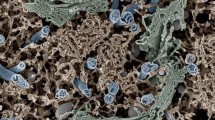Abstract
QUANTITATIVE microscopy is difficult at the ultrastructural level because many organelles and inclusions have irregular shapes and the images represent chance sections through bodies of unknown orientation. Size determination for chromaffin granules is easier than for many other inclusions or organelles because their profiles are usually rounded in section and in isolated granule preparations (Fig. 1) implying a spherical form and so orientation presents no problem.
Similar content being viewed by others
References
Coupland, R. E., Pyper, A. S., and Hopwood, D., Nature, 201, 1240 (1964).
Coupland, R. E., J. Anat., 99, 231 (1965).
Euler, U. S. von, Noradrenaline (Thomas, Springfield, I11., 1955).
Author information
Authors and Affiliations
Rights and permissions
About this article
Cite this article
COUPLAND, R. Determining Sizes and Distribution of Sizes of Spherical Bodies such as Chromaffin Granules in Tissue Sections. Nature 217, 384–388 (1968). https://doi.org/10.1038/217384a0
Received:
Revised:
Issue Date:
DOI: https://doi.org/10.1038/217384a0
- Springer Nature Limited
This article is cited by
-
Monte Carlo Simulation of Release of Vesicular Content in Neuroendocrine Cells
Biological Cybernetics (2006)
-
Characterization of Exocytotic Events From Single PC12 Cells: Amperometric Studies in Native PC12h, DA-Loaded PC12h and Bovine Adrenal Chromaffin Cells
Cellular and Molecular Neurobiology (2005)
-
Quantitative measurements of released amines from individual exocytosis events
Molecular Neurobiology (1997)
-
Three types of Ca2+ channel trigger secretion with different efficacies in chromaffin cells
Nature (1994)
-
Neuron numbers in the superior cervical sympathetic ganglion of the rat: a critical comparison of methods for cell counting
Journal of Neurocytology (1983)





